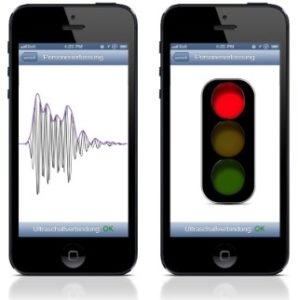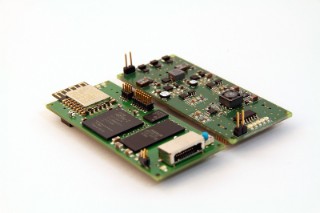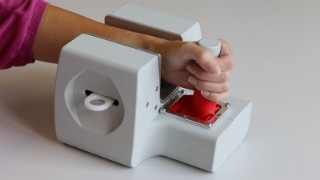Human trafficking is a worldwide problem, and a serious crime that inflicts long-lasting emotional and physical scars on its victims and violates their human dignity. As part of a collaborative, multidisciplinary research project, the Fraunhofer Institute for Biomedical Engineering IBMT has developed a portable, non-invasive, ultrasound scanning device to identify underage victims trying to cross borders illegally. It was specifically designed as a means of uncovering, fighting and preventing human trafficking. The PRIMSA system will be presented at the world’s leading forum for the medical industry, MEDICA 2017, in Düsseldorf, Germany, from November 13 to 16, 2017 (Hall 10, exhibition stand G05).
Human trafficking, especially for the purposes of sex slavery, is a problem of international dimensions, even today. The victims are often underage girls and boys who are smuggled through border controls with fake ID papers that hide their real age. Having a technological solution capable of identifying such cases of fraudulent identity, for example at the borders of the European Union (EU), would do much to widen the scope for action by the authorities and help stop human trafficking. As part of the multidisciplinary PRIMSA research project, which develops prevention and intervention strategies to stop sex trafficking, Fraunhofer IBMT has developed a portable, handheld ultrasound scanning device to quickly identify underage victims of human trafficking.
Border control agents and police authorities are increasingly faced with the still great challenge of determining the age of young immigrants during routine inspections. The only legal method available to them at present involves the use of ionizing X-rays to analyse their bone structure. But because such medical interventions are classified as invasive procedures, they cannot be carried out without a court order. In practice, therefore, the police are reluctant to go this far unless all reasonable doubt can be excluded.

© Photo Fraunhofer IBMT Ultrasound measurement data is transmitted to a smartphone, where it is analysed to determine a person’s age (illustration).
“Our handheld PRIMSA scanning system efficiently determines if a person has reached full legal age by means of ultrasound measurements – a non-invasive technique that can therefore be used without a court order whenever a case of fraudulent identity is suspected,” explains Dr. Holger Hewener, who heads the Working Group for Software Engineering and System Integration at Fraunhofer IBMT. “As a person ages, the wrist bones fuse and the cartilage is replaced with bone in a process referred to as ossification, leaving evidence of the person’ age in the growth plate. Our system makes use of this information by measuring and analysing the sound velocity of ultrasound waves as they pass through ossified areas of the wrist and the growth plates.” The skeletal features of most relevance to determining adulthood are the lower ends of the ulna and radius bones, which in women are usually fully developed by the age of 14 to 17 and 16 to 18, respectively. In men, this development process is normally completed by the age of 16/17 to 20. Consequently, especially in the case of young women, the degree of ossification of the growth plates is a significant indication of skeletal maturity.
“The use of our portable scanner as a rapid screening device is comparable with that of the breathalysers used to test drivers’ alcohol levels,” explains Hewener. “While the results of the test are not accepted as legal evidence per se, they can at least confirm initial suspicions and provide grounds for further testing – which in the case of driving under the influence would mean giving a blood sample for blood-alcohol analysis.” The handheld ultrasound scanner developed by the Fraunhofer scientists could thus give authorities an additional tool for confirming suspected cases of forced prostitution of minors, so they may more easily obtain a court order for an X-ray examination to determine the victim’s exact age.

© Photo Fraunhofer IBMT
Measurement circuits on the left, power supply on the right: Fraunhofer technological excellence is at the heart of the PRIMSA portable test system.
From a technical point of view, the solution consists of a low-cost, handheld, single-channel ultrasound device that is wrapped around the person’s wrist to perform the test. It transmits the measured data via a wireless interface directly to a connected mobile device, such as a smartphone or tablet, for processing and analysis. The results of the analysis are displayed on the screen of the user’s mobile device in an easy-to-read graphical format. Traffic-light colours indicate whether the data corroborates or weakens suspicion of crime. This simplified measurement and display system facilitates use of the technology on-site, in situations typically encountered by law enforcement agents. No special training is required to operate the device and evaluate the measurement results. Smart algorithms derived from machine learning combined with knowledge from practical experience perform the analysis and interpretation of the measured data, and are integrated into the corresponding app.
Embedded in an overall project that includes clinical, social and psychological aspects
“Conventional ultrasound measuring systems, such as those used in diagnostic imaging, are unsuitable for this type of application because the ultrasound wave frequencies they employ are too high,” says Hewener, describing the technological challenges of this project. “The electronics we developed for our compact mobile scanner support the necessary transmission and reflection measurements using low-frequency ultrasound, and wirelessly transmit the raw data to a terminal device for processing and output. And because that device is a consumer electronics device such as a smartphone, i.e. containing standard components, there is no need for the ultrasound scanner hardware to have expensive, customized electronics. This reduces the device’s development costs and results in a particularly low purchase price for the authorities.”
As part of the overall PRIMSA initiative funded by the German Federal Ministry of Education and Research (BMBF), the design and use of the scanner system is also being evaluated by project partners from a social and psychological perspective, accompanied by in-depth reflections on its clinical implications. The system is currently being tested by Saarland University in a clinical study at the university’s medical center in Homburg, Germany, in collaboration with the non-profit association Hope for Freedom. In the altogether difficult and delicate context of the trafficking of children, one of the best possible scenarios would be one in which the border control authorities were able to apprehend minors at their first point of entry into the EU. With a suitably reliable method of identifying underage victims, they could be immediately handed over into the care of the prevention and intervention program.
On the technical development side of the program, Fraunhofer IBMT is collaborating with an industry partner: CEMEC – Intelligente Mechanik GmbH. After completing the evaluation phase, they will develop a prototype based on the existing technology demonstrator, ultimately culminating in the ready-to-use product. This phase too involves ongoing collaboration with government agencies to ensure that the product meets the specific needs and requirements of the real environment in which it will be used. Further studies will also be carried out to verify the reliability of the measurement system and the accuracy of its results. Taking the long view, the new scanning device may open up many other medical applications, for example when diagnosing osteoporosis patients in residential care facilities or at home.
For more information:
The PRIMSA research project: Development of a tool to prevent and intervene in sex trafficking from a multi-disciplinary and multi-institutional perspective:
Source: Fraunhofer Institute for Biomedical Engineering
Disclaimer: Issuers of news releases, not HAPTIC R&D CONSULTING SRL or HAPTIC.ro, are solely responsible for the accuracy of the content.
